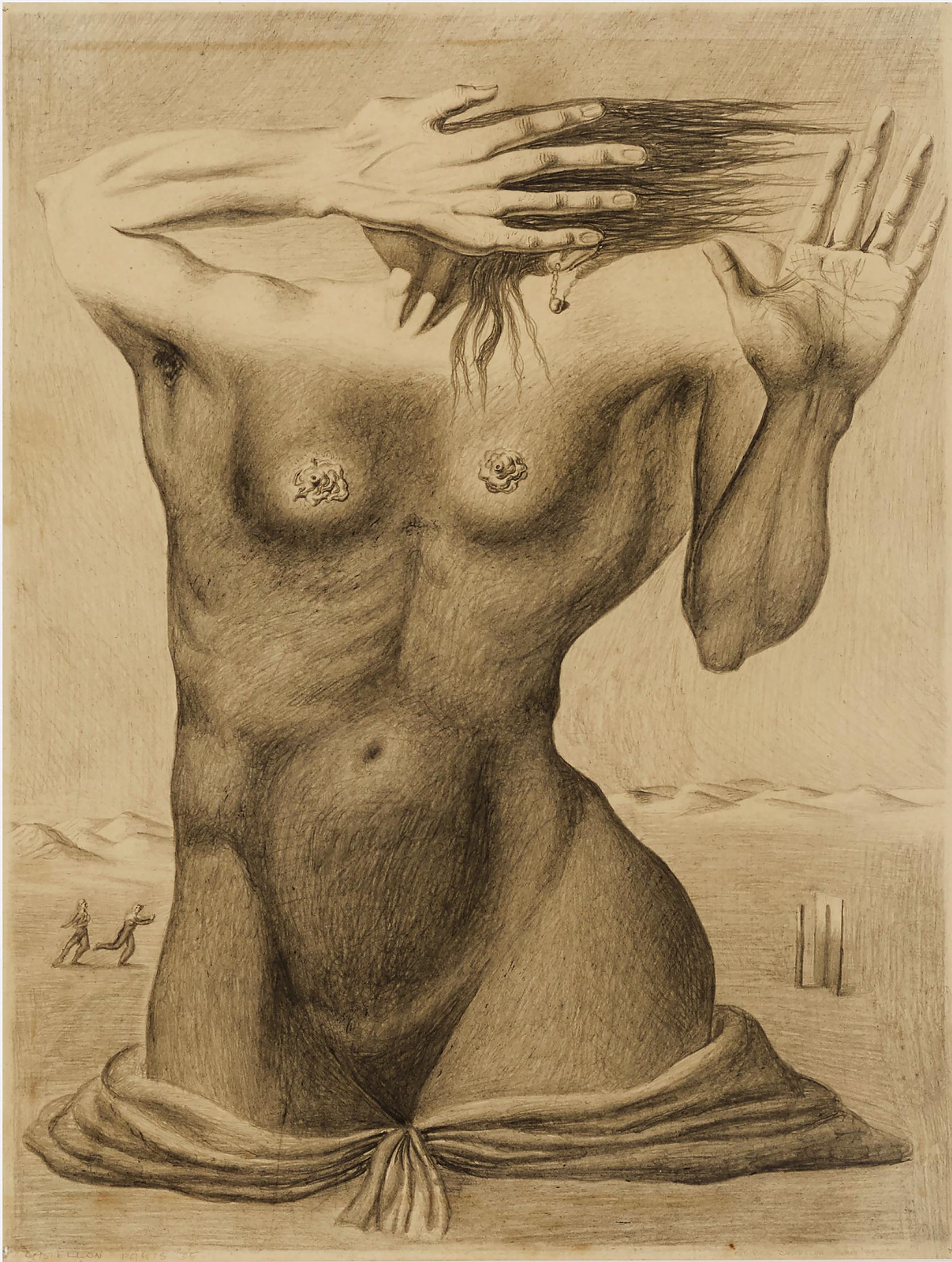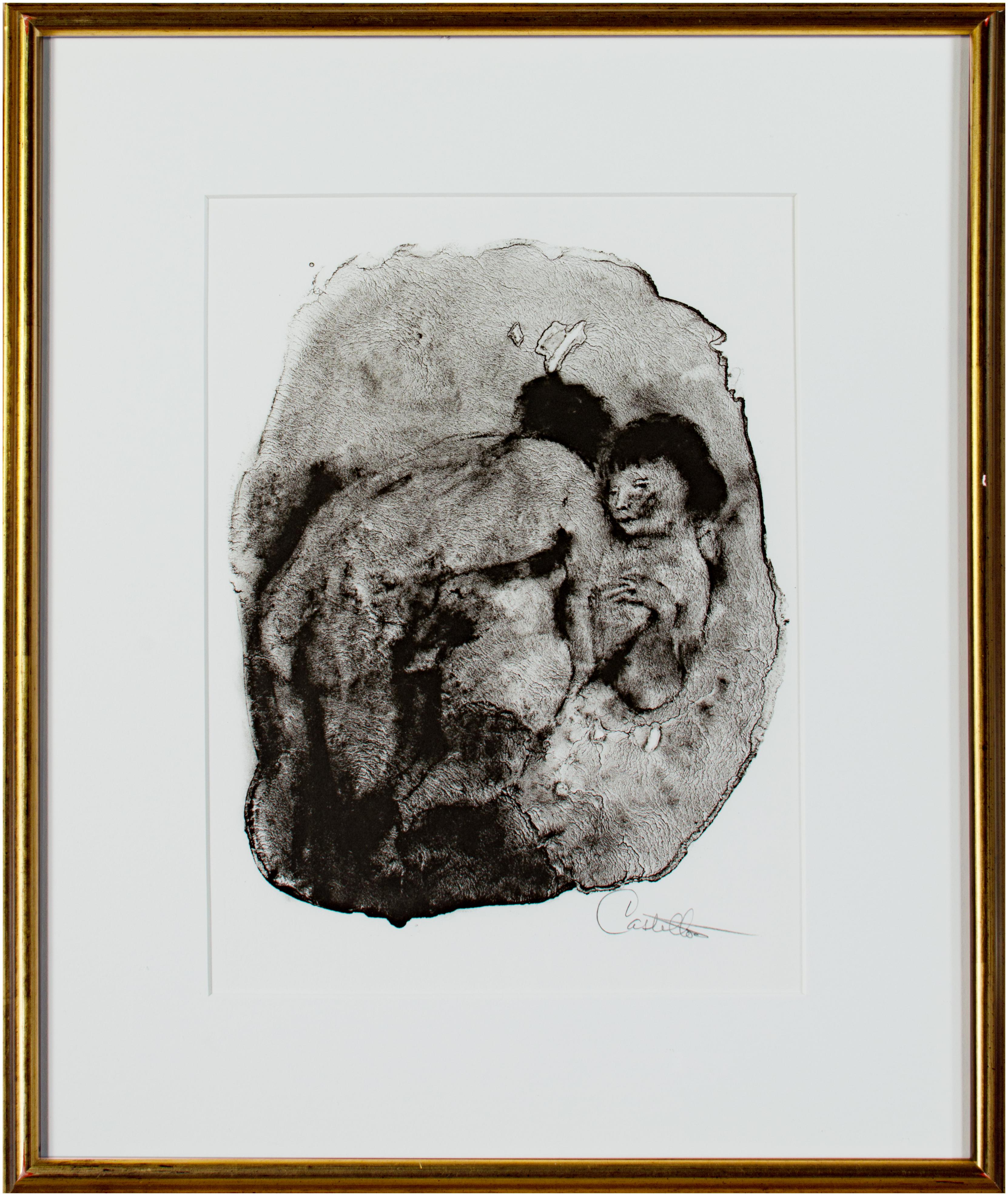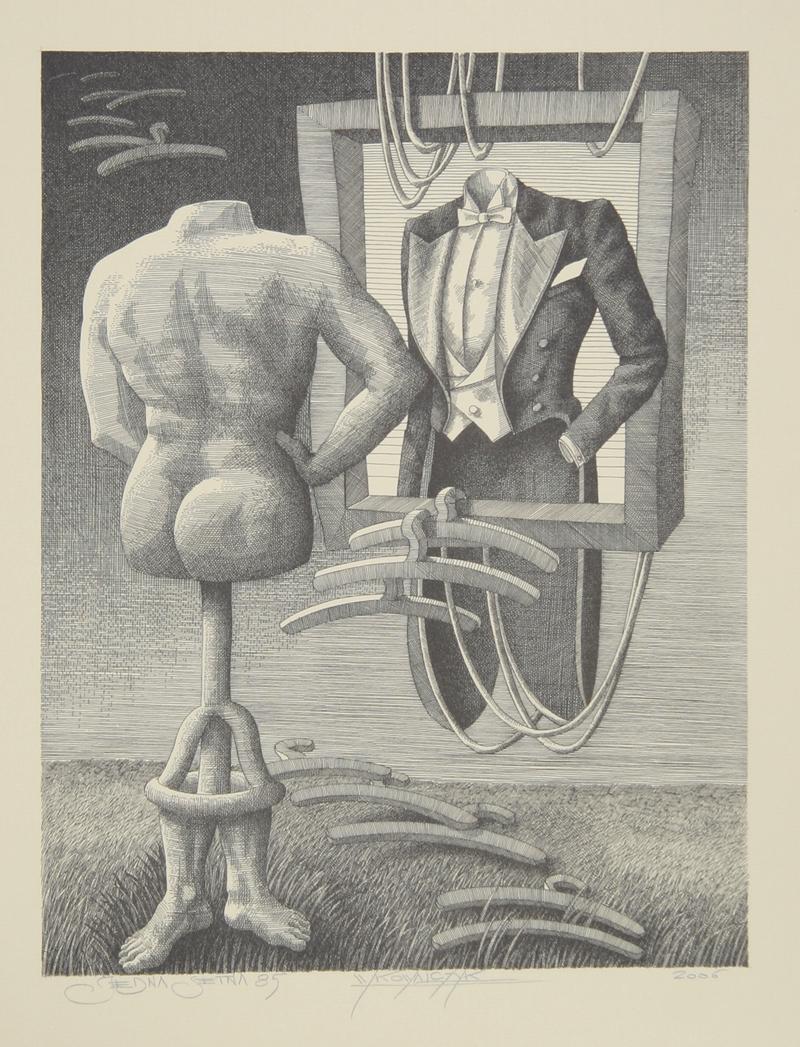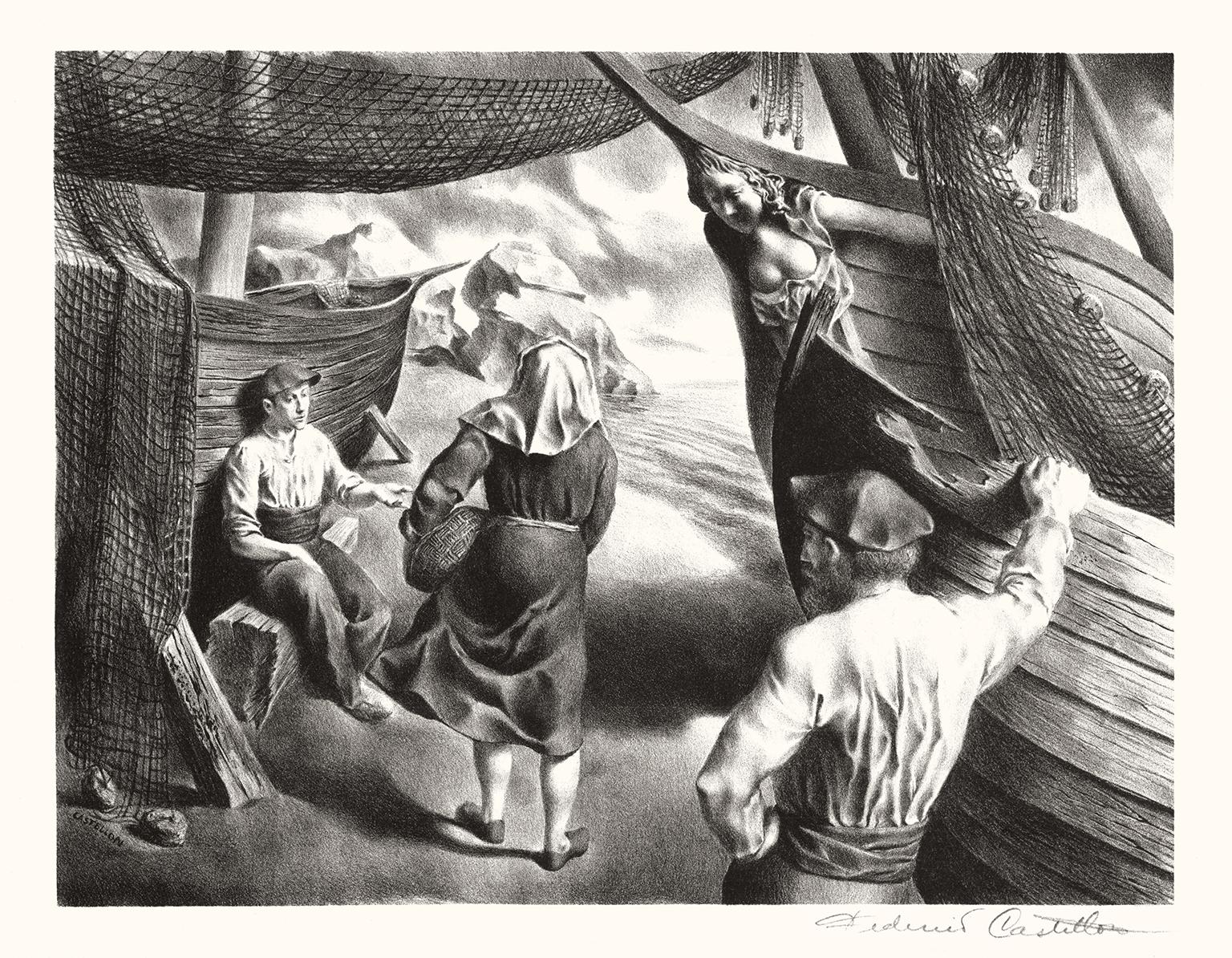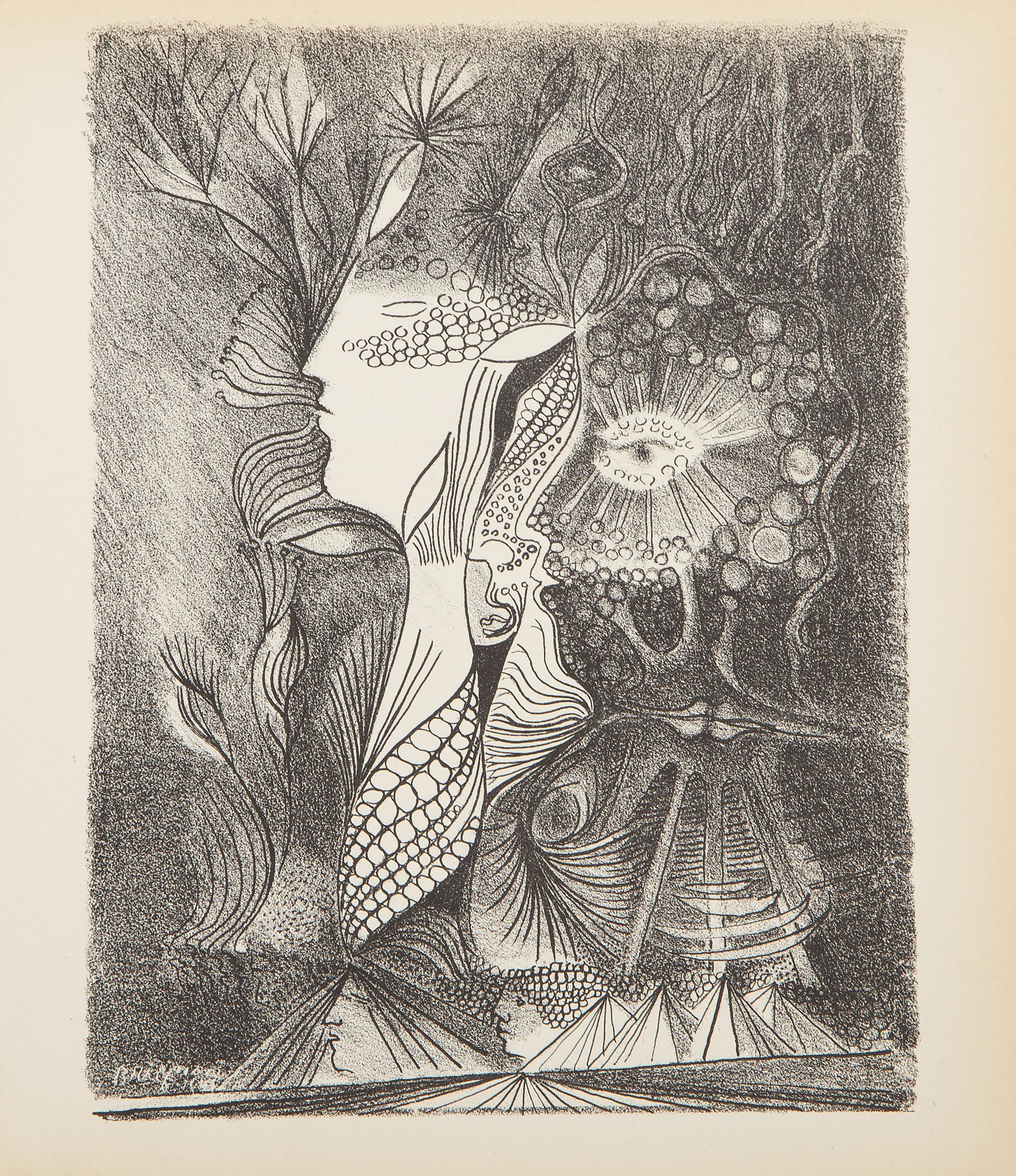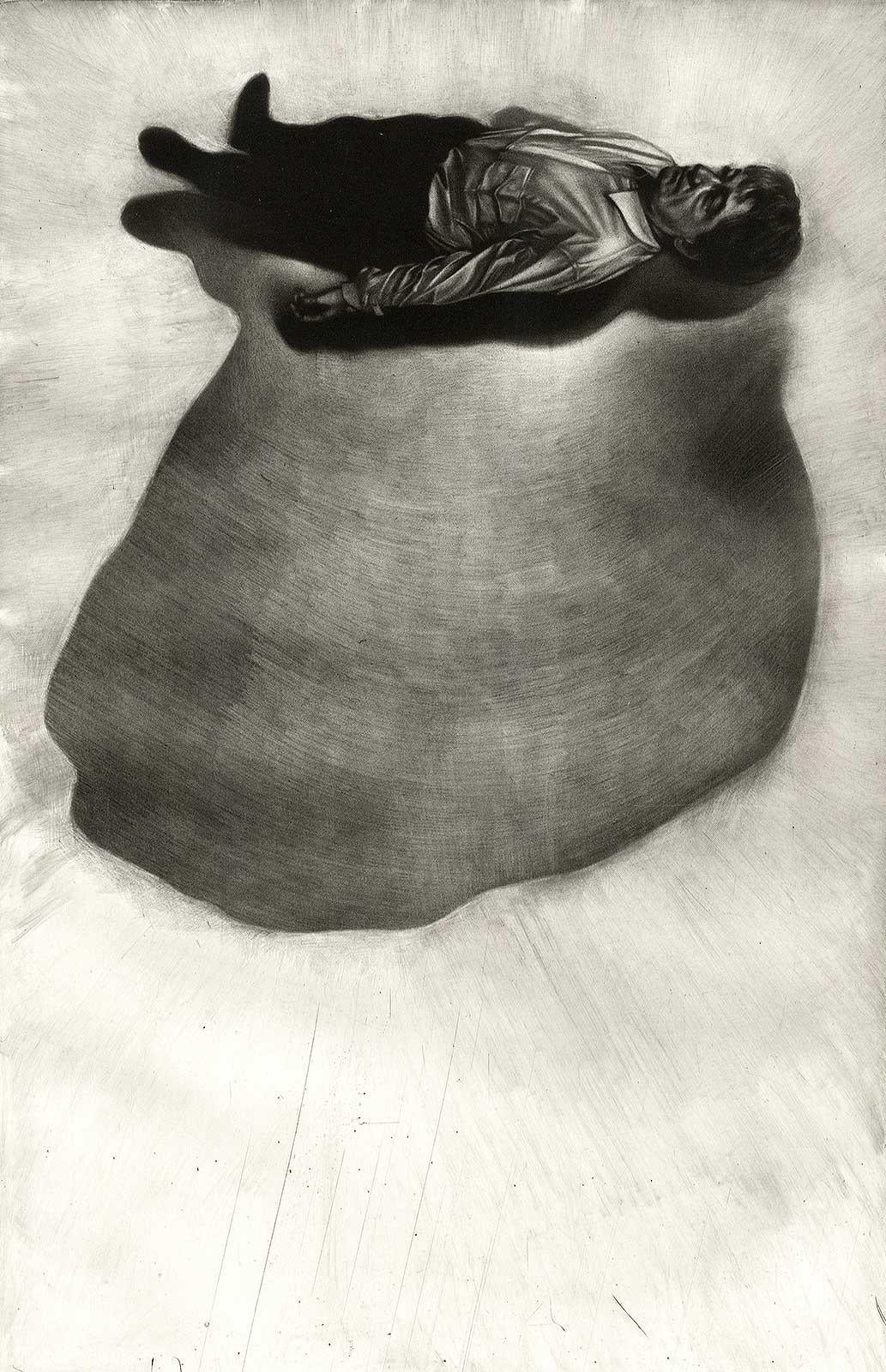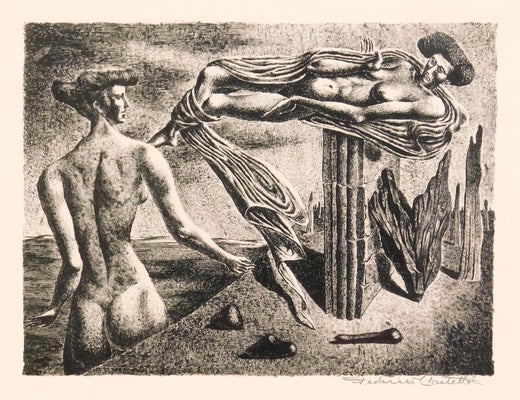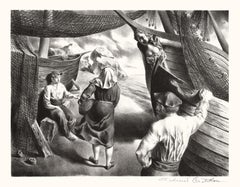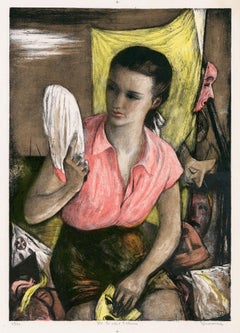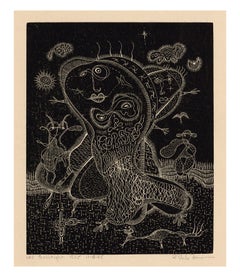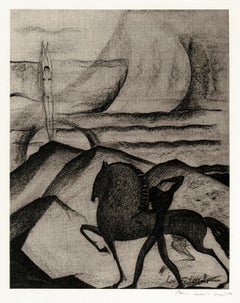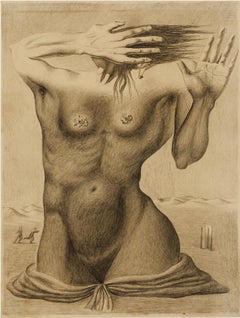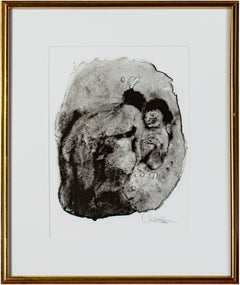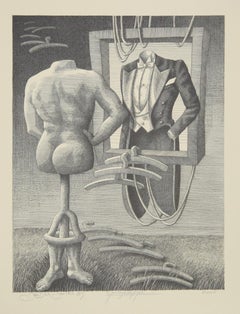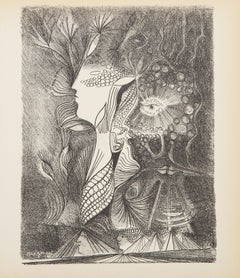Items Similar to 'Body and Soul' — Mid-20th Century Surrealism
Want more images or videos?
Request additional images or videos from the seller
1 of 6
Federico Castellon'Body and Soul' — Mid-20th Century Surrealism1938
1938
$2,400
£1,833.36
€2,106.35
CA$3,431.48
A$3,780.70
CHF 1,957.12
MX$45,520.56
NOK 24,781.84
SEK 23,280.97
DKK 15,727.91
About the Item
Federico Castellon, 'Body and Soul', 1938, lithograph, edition 30, Freundlich 3. Signed in pencil. Signed in the stone, lower left. A fine, richly-inked, atmospheric impression on cream, wove paper, with full margins ( 13/4 to 2 3/8 inches), in excellent condition. Matted to museum standards, unframed. Scarce.
Image size 11 1/4 x 15 1/8 inches (286 x 384 mm); sheet size 15 3/4 x 20 5/16 inches (400 x 516 mm).
In this striking, surrealist composition, Castellon alludes to man's age-old concerns of earthly impermanence and mystical transcendence.
An impression of this work is held in the permanent collection of the Philadelphia Museum of Art.
ABOUT THE ARTIST
“The art of Federico Castellon has a baffling yet fascinating quality. ...The artist sojourns in a world of free imagination, untrammeled by a logic of literal fact. He brings report of strange realms, uncharted seas of symbolism in the unconscious. The emblems and images which he brings back to us are clothed with the most minute and convincing verisimilitude and kind of superrealism."
—Carl Zigrosser, Federico Castellon, His Graphic Works, 1936-1971, August L. Freundlich, Syracuse University, New York, 1978.
Federico Castellon was only seven years old when his family immigrated from Almería, Spain, to Brooklyn, New York. He began sketching at an early age, as imaginative drawings provided an outlet for expression, which was particularly useful for Castellon, given his limited English at the time. Although his teachers recognized his talents as a draftsman, he remained largely self-taught. As a teenager, Castellon regularly visited museums in New York to study the Old Masters. After gaining mastery of realistic rendering, he became inspired by the work of the great modern artists, including Pablo Picasso, Georges Rouault, Diego Rivera, and Giorgio de Chirico.
Shortly after graduating from Erasmus High School, he completed an arts and sciences mural for the school. The mural, informed by his interest in European modernism, attracted critical attention and was exhibited in New York at Raymond and Raymond Galleries before being permanently installed in the school. At about this time, Castellon was introduced to Diego Rivera at a lecture the artist gave on his murals for Rockefeller Center. The older artist took an interest in the young man’s work and brought Castellon’s drawings to the attention of Carl Zigrosser, the Director of the Weyhe Gallery in New York, who gave the eighteen-year-old Castellon his first solo exhibition.
In 1934, with Rivera’s help, Castellon was awarded a four-year fellowship sponsored by the Spanish Government to study art and travel throughout Europe. During this time, he studied painting and printmaking, exhibiting his work at the Casa de Velázquez in Madrid and in the 1935 Paris Exhibition of Spanish and American Artists, which featured Pablo Picasso, Juan Gris, and Joan Miró.
In 1937, Castellon returned to New York and made his first lithograph with master lithographer George Miller. He exhibited in the Whitney Museum Annual in 1937 and 1938. In 1940, the Pennsylvania Academy of the Fine Arts awarded him the Eyre Medal for his lithograph Rendez-vous in a Landscape. He also exhibited at the Weyhe Gallery and the Art Institute of Chicago. In the same year, he received the first of two Guggenheim fellowships. In 1942, he participated in an exhibition at Carnegie Institute.
Although his formal education ended with high school, Castellon remained an avid reader with interests in psychology and philosophy. He became a United States citizen in 1943, and throughout the 1940s and 1950s, his work was informed by his travels abroad, including to China with the U.S. Army, Italy on his second Guggenheim fellowship, and Paris and Madrid, where he relocated his family for a brief period during the late 1950s. He also began teaching during this time, holding successive positions at Columbia University, Pratt Institute, the New School for Social Research, the National Academy of Design, and Queens College. He also took on commissions from American periodicals, most notably LIFE magazine.
In 1947, Castellon exhibited at the Philadelphia Art Alliance and again at the Carnegie Institute. In 1949, he was awarded a National Institute Arts and Letters Grant. He was elected to the National Academy and held solo exhibitions in Paris, Bombay, and New York at Associated American Artists.
Life magazine commissioned Castellon to create a series of paintings illustrating “Memorable Victories in the Fight of Justice” in 1951. He spent 1954 traveling with solo exhibitions of his paintings and graphics throughout South America. Life magazine published his work again in 1955, ‘56, and ‘57. From 1958 to 1960, he began working in sculpture, and from 1961 to 1963, he traveled with his family to France, Spain, and Italy. In 1963, he executed a series of lithographs at the renowned L’Atelier de Jacques Desjobert, Paris, and was elected to the National Academy of Design. Returning to the U.S. in 1964, Castellon held a solo exhibition at Terry Dintenfass Gallery in New York, exhibited at the New York World’s Fair, and received awards from the Philadelphia Print Club and the Society of American Graphic Artists. In 1966, he held a solo exhibition of graphic work at Associated American Artists, and in 1968, he was elected a Member of the National Institute of Arts and Letters. In 1971, the last year of his life, he exhibited at the Biennale Internationale de l'Estampe d'Épinal in Paris.
Castellón's prints and drawings from the 1930s represent some of the earliest examples of surrealism created in the United States. These highly original works predate his travels abroad and the Museum of Modern Art’s seminal exhibition, 'Fantastic Art, Dada, and Surrealism,' in July 1937.
Castellon's work is held in numerous museum collections in America and abroad, including the Amon Carter Museum of American Art, Art Institute of Chicago, Brooklyn Museum, The Butler Institute of American Art, Carnegie Museum of Art, Cleveland Museum of Art, Denver Art Museum, Instituto de Estudios Almerienses (Spain), The Isreal Museum (Jerusalem), Library of Congress, Los Angeles County Museum of Art, Museo Nacional Centro de Arte Reina Sofia (Spain), New Orleans Museum of Art, Pennsylvania Academy of the Fine Arts, Princeton University Art Museum, Metropolitan Museum of Art, Museum of Modern Art, Portland Art Museum, Saint Louis Art Museum, Smithsonian American Art Museum, Springfield Museum of Art, Washington County Museum of Fine Arts, and the Whitney Museum of American Art.
- Creator:Federico Castellon (1914-1971, American)
- Creation Year:1938
- Dimensions:Height: 11.25 in (28.58 cm)Width: 14 in (35.56 cm)
- Medium:
- Movement & Style:
- Period:
- Condition:
- Gallery Location:Myrtle Beach, SC
- Reference Number:Seller: 1032351stDibs: LU532316357312
Federico Castellon
Federico Castellón (1914-1971) was a Spanish-American artist known for his distinctive style that blended surrealism and realism. Born on the island of Almeria, Spain, he moved to the United States with his family at the age of seven. His artistic talent was evident from a young age, and he received a scholarship to study at the New York School of Fine and Applied Art when he was just 15. Castellón's work is characterized by a dreamlike quality, often incorporating elements of fantasy and a strong narrative sense. His early exposure to both Spanish and American cultures profoundly influenced his artistic vision, blending European surrealism with American realism to create a unique visual language. He was particularly renowned for his lithographs, etchings, and illustrations. His illustrations for Edgar Allan Poe's "The Masque of the Red Death" and other literary works are highly regarded for their intricate detail and haunting imagery. In addition to his printmaking and illustration work, Castellón was also a skilled painter and muralist. His paintings often featured surreal, dream-like scenes with a focus on human figures, and his murals are noted for their dynamic composition and rich symbolism. Throughout his career, Castellón received numerous awards and honors, and his work was exhibited widely in the United States and Europe. His legacy continues to influence artists and is recognized in the art world for its unique blend of surrealism and realism, along with a profound narrative quality that speaks to the human condition.
About the Seller
5.0
Recognized Seller
These prestigious sellers are industry leaders and represent the highest echelon for item quality and design.
Platinum Seller
Premium sellers with a 4.7+ rating and 24-hour response times
Established in 1995
1stDibs seller since 2016
324 sales on 1stDibs
Typical response time: 1 hour
Associations
International Fine Print Dealers Association
- ShippingRetrieving quote...Shipping from: Myrtle Beach, SC
- Return Policy
Authenticity Guarantee
In the unlikely event there’s an issue with an item’s authenticity, contact us within 1 year for a full refund. DetailsMoney-Back Guarantee
If your item is not as described, is damaged in transit, or does not arrive, contact us within 7 days for a full refund. Details24-Hour Cancellation
You have a 24-hour grace period in which to reconsider your purchase, with no questions asked.Vetted Professional Sellers
Our world-class sellers must adhere to strict standards for service and quality, maintaining the integrity of our listings.Price-Match Guarantee
If you find that a seller listed the same item for a lower price elsewhere, we’ll match it.Trusted Global Delivery
Our best-in-class carrier network provides specialized shipping options worldwide, including custom delivery.More From This Seller
View All'By the Arks' — Mid-20th Century Surrealism
By Federico Castellon
Located in Myrtle Beach, SC
Federico Castellon, 'By the Arks', 1941, lithograph, edition 250, Freundlich 10D. Signed in pencil. Signed in the stone, lower left. A fine, atmospheric impression on cream, wove pap...
Category
1940s Surrealist Figurative Prints
Materials
Lithograph
'I'll Be What I Choose' — Mid-century American Surrealism
By Benton Murdoch Spruance
Located in Myrtle Beach, SC
'I'll Be What I Choose: Vanity of Ambition', color lithograph, 1949, edition 40, Fine and Looney 281. Signed, titled, and numbered '23/40' in pencil. Initialed in the stone, lower ri...
Category
1940s American Modern Figurative Prints
Materials
Lithograph
$960 Sale Price
20% Off
'Bullfight'— Mid-century American Surrealism
By Robert Vale Faro
Located in Myrtle Beach, SC
Robert Vale Faro, 'Bullfight', wood engraving, 1945, edition 15. Signed, dated, titled, and numbered '105' (the artist's inventory number) and '13/15' in pencil. A fine, richly-inked impression, on cream wove paper, with full margins (1 1/16 to 2 3/8 inches), in excellent condition. Scarce. Matted to museum standards, unframed.
Image size 5 1/16 x 4 1/16 inches (129 x 103 mm); sheet size 8 9/16 x 6 5/16 inches (217 x 160 mm).
An impression of this work is included in the museum collection of the National Gallery of Art.
ABOUT THE ARTIST
Robert Vale Faro (1902-1988) was a well-known modernist architect and artist associated with the Chicago Bauhaus. He received his degree in architecture and design from the Armour Institute in Chicago and worked at L'Ecole des Beaux-Arts, Paris, from 1924-27, where he was influenced by Harry Kurt Bieg and Le Corbusier. Upon his return to Chicago, Faro worked with the important modernist Chicago architects George and William Keck under Louis Sullivan.
Faro founded the avant-garde printmaking group Vanguard in 1945. The group counted Atelier 17 artists Stanley William Hayter, Sue Fuller, and Anne Ryan as New York members and Francine Felsenthal...
Category
1940s Surrealist Abstract Prints
Materials
Woodcut
$360 Sale Price
20% Off
Rendez-Vous — Early 20th-Century Modernism
By Boris Lovet-Lorski
Located in Myrtle Beach, SC
Boris Lovet-Lorski, Untitled (Rendez-Vous), lithograph, edition 250, 1929. Signed in pencil. Signed in the stone, lower right. From a suite of 10 lithographs published by the artist ...
Category
1920s American Modern Nude Prints
Materials
Lithograph
'Salient in February' — Mid 20th-Century Surrealism
By Edward August Landon
Located in Myrtle Beach, SC
Edward Landon 'Salient in February', color serigraph, 1945, edition 40, Ryan 166. Signed in pencil. Titled, dated, and annotated 'ED. 40' in pencil. A fine impression, with fresh col...
Category
Mid-20th Century Surrealist Abstract Prints
Materials
Screen
'Together' — Mid-Century Surrealism, Atelier 17
Located in Myrtle Beach, SC
Ian Hugo, 'Together', from the portfolio 'Ten Engravings'. engraving, 1946, edition 50. Signed, dated, titled, and numbered '22/50' in pencil. A fine impression, with delicate overall plate tone, on cream wove paper, the full sheet with wide margins (2 7/8 to 5 1/2 inches), in excellent condition. With the blind stamp 'madeleine-claude jobrack EDITIONS', in the bottom right margin. Matted to museum standards, unframed.
Image size 5 7/8 x 4 7/8 inches (149 x 124 mm); sheet size 15 x 11 1/8 inches (381 x 283 mm).
Collection: Indianapolis Museum of Art.
Ian Hugo originally created "Ten Engravings" in 1945 and the portfolio included a foreword by his partner and collaborator, Anais Nin. In 1978, Hugo republished the portfolio with Madeleine-Claude Jobrack, an American master printmaker who studied under Stanley William Hayter at Atelier 17, Paris, and with Johnny Friedlaender. When Jobrack returned to the States she managed the Robert Blackburn Printmaking Studio in New York before opening her own printing studio, Madeleine-Claude Jobrak Editions.
“The sign of the true artist is one who creates a complete universe, invents new plants, new animals, new figures to transfer to us a new vision of the universe in which dream and reality fuse. Ian Hugo's plants have eyes, the birds have the delicacy of dragonflies, their feathers have the shape of fans. Humor is apparent in every gesture. He uses a fine spider web to give a feeling of flight, speed, lightness. The body of a woman reveals the structure of a leaf, a plant. Wings are moving in a world unified by mythological themes. This is an animated world, humorous and levitating, elusive and decorative, which by its unique forms and shapes gives us the sensation of a rebirth, a liberation from the usual, the familiar, a visit to a new planet.”
—Anais Nin, from the forward to the portfolio ‘Ten Engravings’
ABOUT THE ARTIST
Ian Hugo was born Hugh Parker Guiler in Boston, Massachusetts, on February 15, 1898. His childhood was spent in Puerto Rico—a "tropical paradise," the memory of which stayed with him and surfaced in both his engravings and his films. He attended school in Scotland and graduated from Columbia University where he studied economics and literature.
Hugo was working with the National City Bank when he met and married author Anais Nin in 1923. The couple moved to Paris the following year, where Nin's diary and Guiler's artistic aspirations flowered. Guiler feared his business associates would not understand his interests in art and music, let alone those of his wife, so he began a second, creative life as Ian Hugo. Ian and Anais moved to New York in 1939. The following year he took up engraving and etching, working at Stanley William Hayter’s experimental printmaking workshop Atelier 17, established at the New School for Social Research.
Hugo began producing surreal images often used to illustrate Nin's books. For Nin, his unwavering love and financial support were indispensable—Hugo was the "fixed center, core... my home, my refuge" (Sept. 16, 1937, Nearer the Moon, The Unexpurgated Diary of Anais Nin, 1937-!939). Fictionalized portraits of Higo and Nin appear in Philip Kaufman's 1990 film drama of a literary love triangle, Henry & June.
Inspired by comments that viewers saw motion in his engravings, Hugo took up filmmaking. He asked the avant-garde filmmaker Sasha Hammid for instruction but was told, "Use the camera yourself, make your own mistakes, make your own style." Hugo embarked on an exploration of the film medium as a vehicle to delve into his dreams, his unconscious, and his memories. Without a specific plan, He would collect resonant images, then reorder or superimpose them, seeking a sense of self-connection through the poetic juxtapositions he created. These intuitive explorations resembled the mystical evocations of his engravings, which he described in 1946 as "hieroglyphs of a language in which our unconscious is trying to convey important, urgent messages."
In the underwater world of his film ‘Bells of Atlantis,’ the light originates from the world above the surface; it is otherworldly, out of place, yet essential. In ‘Jazz of Lights,’ the street lights of Times Square become in Nin's words, "an ephemeral flow of sensations." This flow that she also calls "phantasmagorical" had a crucial impact on Stan Brakhage, who said that without Jazz of Lights (1954), "there would have been no Anticipation of the Night" his autobiographical film which ushered in a new era of experimental modernist filmmaking.
Hugo lived the last two decades of his life in a New York apartment high above street level. In the evenings, surrounded by an electrically illuminated man...
Category
1940s Surrealist Figurative Prints
Materials
Engraving
You May Also Like
Surrealist Nude Female Figure
By Federico Castellon
Located in Miami, FL
This is an important work that is loaded with Surrealist iconographies. The shape of her hands is echoed in the shape of her hair. Tiny man and woman figures...
Category
1930s Surrealist Figurative Drawings and Watercolors
Materials
Graphite, Archival Paper
"Erotica III Marginala, " from the Mask of the Red Death series signed Castellon
By Federico Castellon
Located in Milwaukee, WI
This lithograph was one of sixteen Federico Castellón produced in 1968, published by Aquarius Press, to illustrate Edgar Allan Poe's 1832 story 'The Mask of the Red Death.' The image...
Category
1960s Surrealist Figurative Prints
Materials
Lithograph
Untitled - VII, Surrealist Lithograph by Wojtek Kowalczyk
Located in Long Island City, NY
Untitled - VII
Wojtek Kowalczyk, Polish (1960)
Date: 2005
Lithograph, signed in pencil
Size: 19.5 in. x 13.5 in. (49.53 cm x 34.29 cm)
Category
Early 2000s Surrealist Landscape Prints
Materials
Lithograph
Untitled from Le Surrealisme en 1947, Surrealist Lithograph by Serge Brignoni
Located in Long Island City, NY
Serge Brignoni, Swiss (1903 - 2002) - Untitled from Le Surrealisme en 1947, Year: 1947, Medium: Lithograph, Edition: 950, Size: 9 x 7.75 in. (22.86 x 19.69 cm), Printer: Mourlot, Pa...
Category
1940s Surrealist Prints and Multiples
Materials
Lithograph
Personne Seule Etendue
By Maurice Pasternak
Located in New Orleans, LA
Maurice Pasternak has created a surreal landscape that includes traditional images of a sun-filled sky, dark shadows cast on water and through leafy trees all under the guise of thre...
Category
Late 20th Century Surrealist Landscape Prints
Materials
Mezzotint
Figures - Lithograph - 1996
Located in Roma, IT
Figures is an artwork realized by an artist of the last 20-th century.
Lithograph, 50 x 35 cm.
Edition 129/150.
Dated, hand signed lower side.
Good conditions!
Category
1970s Surrealist Figurative Prints
Materials
Lithograph
More Ways To Browse
Spanish Library
Anatole Krasnyansky Serigraph
Andre Lambert
Andy Warhol Indian Poster
Andy Warhol Mickey Mouse
Andy Warhol Moonwalk
Angel Bracho
Antique Japanese Hair Combs
Antique Print Guatemala
Antonio Nocera
Aristocrat Watch
Arnold Herstand
Astro Boy Vintage
Aubrey Beardsley Salome
Babar Art
Basquiat The Offs Print
Bay Of Angels Chagall
Bearden Jamming
